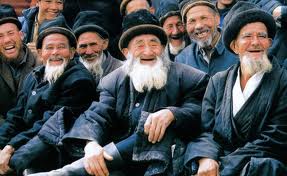Image:

Body:
Historical Narratives and Uyghur Marginalization in China’s Development of Xinjiang
by tuftshemispheres on January 15, 2014
In the aftermath of the 2009 ethnic riots in Urumqi, the capital of the far western Chinese province of Xinjiang, journalist John Pomfret made a striking comment on National Public Radio’s Diane Rehm Show, “In the early years of this century they [China] launched a program called the Great Western Development Scheme, and in justifying a need for such a program which involved the massive influx of investment into Xinjiang and other provinces in the west, they’ve used direct quotes from Manifest Destiny texts from the 19th century in the United States.” The implication here is that central government’s effort to develop Xinjiang is not only a part of its economic growth policy, but also a nation-building process that draws upon the American model. Applying this logic, the exclusion of the Uyghur people native to Xinjiang in modern development is treated as a naturally occurring symptom of progress rather than a barrier to it.
The idea that ethnic marginalization plays a role in consolidating the nation state is well grounded in history. Influenced by Social Darwinian thought that promulgated race-specific characteristics, nationalist intellectuals in the late 19th and early 20th centuries equated Chinese identity to Han ethnicity as a way to counter the weakness of the ruling Manchu elite in face of Western encroachment. This was reflected in the progressive movements of early Republican China that bundled racial purity with national strength. For example, a poster (see page 89) distributed in 1928 by the National Anti-Opium Association depicted, young, strong Han citizens wielding patriotic slogans and beating a “white” morphine demon and a “black” opium demon.
During the same era, “Uyghur” was constructed as a distinct ethnicity and was granted official recognition in the 1930s. Previously, Uyghurs identified themselves according to their locality rather than any overarching racial or cultural category. The assertion of a unified Uyghur ethnicity was necessary for achieving Xinjiang’s political autonomy in the nationalist context.
Today, Xinjiang’s autonomy is in name only. Although the appointment of Uyghurs to top provincial government positions is enforced, Hans are still given positions within the Chinese Communist Party (CCP) that grant the most decision making power regarding Beijing’s interests for the province as a whole. This has allowed the government to carry out a major development program in Xinjiang with little say from the Uyghurs affected by it.
China’s investment in Xinjiang over the last twenty years has created the most dramatic transformation for the province in its entire 250 year history of being under Chinese rule. The movement of people and capital has been heavily subsidized in order to tap into Xinjiang’s abundance of oil, natural gas and cotton. Xinjiang also serves as a strategically important buffer zone to Central Asia and the Indian Subcontinent. The CCP does not want to weaken its position in the region by loosening political control, making the economic anchoring of Xinjiang to the rest of China a top priority.
The upside of this development has been felt by the local population in the form of raised living standards and access to broader markets. A number of specialized farmers have prospered by selling their produce both within Xinjiang and to the rest of China. The downside, however, is reflected in the deep inequalities between Han immigrants and Uyghur locals. The majority of the benefits from emerging industries in Xinjiang have gone to Han consumers in eastern China. Because traditional farming activities have become less lucrative, there is increased pressure on Uyghurs to find work in the Xinjiang’s rapidly developing cities, where hiring is discriminatory because of the education and language barriers faced by Uyghurs. As a result, the Uyghur population has experienced significant underemployment.
The bleak outlook for Uyghurs hoping to succeed in this Han dominated system has led to increased tension drawn upon ethnic lines. Protests against the Han influx became increasingly violent during the 1990s in response to the CCP’s tightening grip on Xinjiang’s administration. Although protests decreased in the early 2000s, the riots of 2009 were a bloody wake-up call to the worsening state of Uyghur-Han relations. The Chinese government, however, blamed these acts of violence not on state policy but on the encouragement of international agitators such as Rabiya Qadir, the leader of the World Uyghur Congress. The government labels all Uyghur violence as “terrorist acts” as a way to associate Uyghur separatism with global Islamic extremism and point the blame to causes external to Xinjiang’s domestic situation.
Violent incidents have continued since 2009. Widespread media coverage was given to the car crash in Tiananmen Square this October that killed five, allegedly carried out by Uyghur separatists. More recently, 16 people died in a clash on the western edge of Xinjiang.
Given the government’s unwillingness to acknowledge its own role in creating ethnic tensions, incidents like these are expected to continue. A spokesperson for the Chinese embassy in Washington D.C. appeared on the Diane Rehm Show and referred to Uyghur “grievances” with a quote and unquote. This is telling of the impact of an antiquated nationalist narrative on China’s approach to development. When China sees itself as having a “civilizing mission”, as indicated by the comparison of investment in Xinjiang to the Manifest Destiny, it disregards the full legitimacy of ethnic identities counter to the Han construction of Chinese nationality. As long as China’s western policy is informed by this historical analogy, Uyghur exclusion will remain a systemic part of Xinjiang’s development.
Further Reading: Bovingdon, Gardener. “Xinjiang.” Politics in China. (Oxford: Oxford University Press, 2010): 336-355.
Shehryar Nabi is a senior majoring in history
